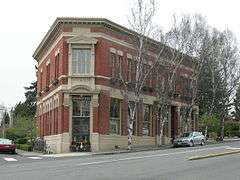Joshua Sears Building
|
Joshua Sears Building | |
 | |
 | |
| Location | Kirkland, Washington |
|---|---|
| Coordinates | 47°40′51″N 122°12′31″W / 47.68083°N 122.20861°WCoordinates: 47°40′51″N 122°12′31″W / 47.68083°N 122.20861°W |
| Built | 1891 |
| Architectural style | Romanesque Revival, Beaux Arts |
| NRHP Reference # | [1] |
| Added to NRHP | August 3, 1982 |
The Joshua Sears Building is a historic building in Kirkland, Washington located at the northwest corner of Market Street and Seventh Avenue, Kirkland's historic commercial core. It is listed on the National Register of Historic Places. It was built in 1891 by Boston philanthropist and capitalist, Joshua Sears, who was heavily invested in Peter Kirk's Great Western Iron and Steel Company and who planned to open a bank in town. As a result of the Panic of 1893, the steel mill and the bank never opened but the Sears building survives today as a reminder of what might have been in Kirkland. On August 3, 1982, it was added the National Register of Historic Places. In December 2015 the building was purchased by local attorney Simeon Osborn and his wife Monica Hart, who stated they plan to keep the current business and residential tenants.[2]
Original and present appearance
A single detached structure, the building is an irregular polygon in plan, measuring 10' x 81' x 52' x 42' x 61'. It is two full stories with a full basement. The main entrance is on the southeast corner with a second major entrance centered on the east facade. The building is Italianate in style and is constructed of red brick in the stretcher bond pattern. The foundation is also brick. The roof is flat and covered with tar and gravel.
There is a continuous pressed metal cornice around the east and south roof lines. The cornice contains brackets, dentils, and a decorated frieze. There are belt courses of cast ornamental concrete over raised brick occurring at four levels: on the first floor under the window sills a wide band above the first floor windows; on the second floor as a continuous band window sill and just below the metal frieze of the cornice. This cast concrete is used throughout the exterior to imitate stone.
There are several types of window treatment. These are on the west facade: segmental with radiating voussoirs of plain brick and cast concrete lug sills; south facade: first floor, plain double hung windows; above these are a second row of small windows approximately 2½' x 4', semi-circular with cast concrete surrounds and pressed metal decorative keystones; second floor, standard double hung with shaped concrete lintels with raised keystones and continuous cast concrete sills; east facade: first floor, large fixed windows with transoms above and continuous sills and headers of cast concrete; second floor, the same as the south facade; the north facade has no windows.
The main entrance, which was for the bank, is on the southeast corner. The door is recessed and approached by three granite stairs. Originally, there were paneled double doors but they have been replaced by a standard plain single door. The door architrave consists of brick pilasters with cast concrete bases and pressed metal Ionic capitals and a segmental pediment also of pressed metal. The second story window surround continues the classic effect with a triangular pediment supported by brackets over two double hung windows, since replaced by a fixed, four pane window imitating the original. Above this pediment is a rectangular cast concrete cartouche bearing the name "SEARS". The second entrance is centered on the east facade and bears many of the same features: pressed metal pediments, etc.
History
The Sears Building was built in 1891 by Boston millionaire, philanthropist and Kirkland investor Joshua Montgomery Sears as part of the speculative land boom following Peter Kirk's proposal of building a steel producing mecca that would rival Pittsburgh on the east side of Lake Washington.[3] The building cost $18,000 to build, at the time the most expensive being built in Kirkland outside of the steel mill itself. The bricks were pressed from local clay at Peter Kirk's own brick works on what is now Peter Kirk Park. The building originally intended to house a bank at the corner. Sears outfitted the entire interior and even hired a partial staff but with the arrival of the Panic of 1893, the doors, like the steel mill, never opened. In the years after the bust, the building, like many others in the area remained mostly vacant. The corner space was eventually occupied by a printing company and later a grocery store. An electric supply store occupied one of the smaller storefronts for over twenty years. At one point the building's upper floors, originally intended for office space, were divided into seven apartments. On August 3, 1982, it was added the National Register of Historic Places. As of 2005 the building housed a religious bookstore and a real estate office.[4] In 2015 the building was purchased by Local attorney Sim Osborn and his wife Monica Hart, the couple bought the building with plans to preserve its historic features and aesthetics for future generations.[5]
See also
References
- ↑ National Park Service (2007-01-23). "National Register Information System". National Register of Historic Places. National Park Service.
- ↑ http://www.kirklandreporter.com/news/366727731.html
- ↑ Lentz, Florence K. (1991). Centennial Snapshots. Seattle: Northwest Interpretive Association. p. 88.
- ↑ Grindeland, Sherry "A Walk Through History: Kirkland at 100" The Seattle Times 29 June 2005. Retrieved December 19, 2013
- ↑ TJ Martinell "Kirkland couple buys historic Joshua Sears Building" Kirkland Reporter 29 January 2016
History
- "Kirkland Town of Brick Business Blocks 150 New Buildings" Unknown publication 1890. Retrieved December 31, 2009 [Kirkland Heritage Society]
- 'Kirkland couple buys historic Joshua Sears Building" Kirkland Reporter January 29, 2016